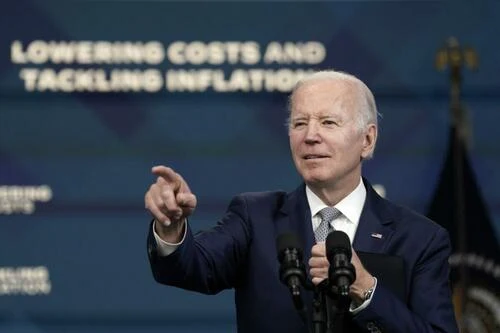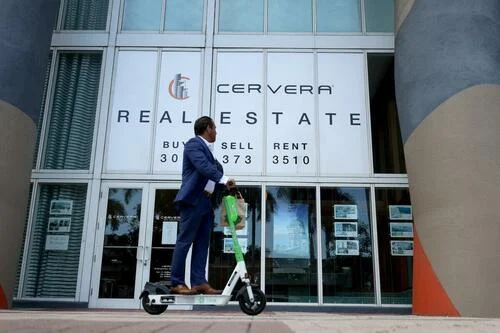Authored by Michael Washburn via The Epoch Times,
The dramatic rise in home prices and mortgage rates in the early months of 2022 has had a relatively limited effect on wealthy buyers and sellers, but has had a severe impact on lower-income Americans - and the Democratic Party may pay a steep price for their frustrations in the November midterm elections and beyond, according to real estate analysts and commentators.
Average payments on mortgages went from 3 percent to 5 percent in the first three months of the year, and are now 38 percent higher than a year ago, according to a Politico report citing figures from real estate listing service Zillow.
Partly because of inflation, the average rate on 30-year mortgages this week hit 5.46 percent, the highest figure since August 2009, according to Bankrate statistics.
Rates are up across the board, including 30-year fixed rates, 15-year fixed rates, and 5/1 adjustable-rate mortgage (ARM) rates. As of April 2022, the median home price in America stood at $344,141, a 20.9 percent leap from a year before, Zillow states.
Inflation, driven by the pandemic and other factors including the government’s expansionist monetary and fiscal policies, has contributed to adverse market conditions where lower-income voters whom the Democratic Party claims to represent have it the hardest. The sharply rising mortgage rates, compounded by an inventory shortfall, are driving many prospective buyers out of the market, experts say.
President Joe Biden replies to questions from the media after delivering remarks on inflation and lower costs for working families in the South Court Auditorium at the White House in Washington, D.C., on Tuesday, May 10, 2022. (Yuri Gripas/Abaca Press/TNS)
Lower-End Buyers Bear the Brunt
Some who work in real estate say that the competition for a limited number of houses has reached levels that they have rarely seen in years, and affects lower-income buyers above all.
“I think it probably does disproportionately affect the lower end. If you’re at the higher end of the market, and rates are in the 4s or 5s, that’s not a crazy number. But if you’re trying to get in, a fluctuation in the interest rates can price you out and make you not able to compete with the cash developers,” said Zachary Schorr, a real estate attorney based in Los Angeles.
“The real estate market has been going up and up, outpacing income. As that disparity keeps growing, it becomes increasingly difficult for the lower end to get into entry-level homes,” he said.
High inflation and global uncertainty fostered by Russia’s Feb. 24 invasion of Ukraine are commonly offered as reasons for high mortgage rates, but they only partly explain why buyers have it so hard. The relatively low number of houses on the market is due partly to the fact that some homeowners who might otherwise be inclined to sell do not want to have to go looking for new homes in the current market, according to Mark Pruner, a sales executive at Compass Real Estate in Greenwich, Connecticut.
“One of the reasons we have low inventory is that many sellers, particularly ones who bought post-recession, have ‘silver handcuffs’ in that they have a very low-interest rate on their mortgage. If they were to list their house, i.e., add it to the inventory and alleviate pressure on buyers, they would be looking at higher prices, higher interest rates, and substantially higher monthly payments” on a new home they set out to acquire, Pruner explained.
Hence the market in which Pruner operates is far more favorable to wealthy buyers. In Greenwich, 50 percent of the home sales he handles are cash deals, and 20 percent take place without a mortgage contingency in the contract, because buyers are not worried about their ability to get financing.
The median price for sales in Pruner’s market is $384,400, and in 2021 the lowest value of a home sold through his agency was $450,000, he said.
Pictures of properties for rent or sale hang on the window of a real estate company on Sept. 29, 2021 in Miami, Florida. (Joe Raedle/Getty Images)
Buyers Give Up
In the face of these trends, some buyers are simply abandoning their plans.
“It’s gotten to a point where it is almost impossible for real estate brokers to do their job. There is such a lack of inventory, and so many more buyers than sellers,” said Mark Scheier, managing attorney of Scheier Katin & Epstein, an Acton, Massachusetts-based law firm with a focus on real estate.
“It just becomes a joke for a lot of people. After six or seven tries at buying a house, they just give up. I’ve had two clients in the last week tell me, because of increasing mortgage rates, that they’re out of the buying market and will continue to rent. I think you’re going to see a lot more of that,” Scheier added.
The current state of the market is highly favorable to cash buyers unaffected by changes to the interest on mortgage loans.
“I’ve never seen so many cash buyers in over four decades. They are a tremendous number,” Scheier said.
The lack of inventory is so severe that trying to be a real estate agent in this market exacts a toll, said Cara Ameer, a realtor at Coldwell Banker in Orange County, California.
“Real estate agents are worn out from having to vigorously monitor inventory 24/7 to be ready literally to pounce on a new listing the moment it hits,” she said. In addition, buyers feel enormous pressure to buy sight unseen or to commit to prices way beyond what they can reasonably afford in order to secure a property before cash purchasers snatch it up.
The rise in mortgage rates, and the higher monthly payments on homes, are likely to hit people at the lower end of the socio-economic scale the hardest even as they contemplate purchases in the mid-market range. In Acton and in Cape Cod, where Scheier handles large numbers of transactions, a $500,000 house is a relatively modest one.
“For the poor couple trying to scrape together $100,000 as a down payment, now they’re looking at an increase of $500 a month or more over what they would have paid three months ago. That’s going to create significant changes in the whole dynamics,” Scheier said.
Scheier has noted a number of changes in home-buying protocols in the markets where he works. Some buyers are foregoing spending money on inspections of homes prior to closing, even though inspections may be necessary to alert them to potentially serious damages or structural flaws that may be expensive to fix. Some are waiving mortgage contingencies, which are clauses in homebuying contracts that give buyers an out if financing falls through and provides that the seller will return their deposit and relist the home.
A home for sale in Mount Lebanon, Pa., on Sept. 21, 2021. (Gene J. Puskar/AP Photo)
Thwarted Dreams
The pandemic of the past two-plus years inspired some people to reflect on how they live and on whether they might benefit from having a secondary property or a new primary residence, observed Ameer.
Besides remote working arrangements, the pandemic prompted some people to think about taking advantage of the relatively low mortgage rates of 2020-21. For some of these people, the changes to home prices and mortgage rates have hampered or altogether ruled out such moves.
“Prices have jumped very quickly, and in some cases completely priced buyers out of the market or caused them to readjust what they can afford and make some big compromises,” Ameer said.
“This trend, coupled with low inventory, is causing multiple offers across all price points which are driving prices up even further on top of some crazy asking prices to begin with. With rising interest rates, it is the trifecta of the perfect storm, unfortunately for buyers and would-be buyers who would sell their home if they could afford somewhere else to go,” she added.
Ameer described a market in which would-be buyers face heightened pressures all around. The rents that they currently pay have risen markedly, which prompts them to look seriously at buying, but the rapid changes to prices and interest rates have simply priced many of them out. The trend is the same across many of the biggest and most sought-after real estate markets throughout the country, from California to Massachusetts to Florida.
“I regularly talk with agents, many working with buyers, including first-time buyers. Yes, many are being priced out of the market,” said Francois Gregoire, a realtor and appraiser based in Tampa Bay, Florida.
Appraisals that Gregoire has undertaken recently in Pinellas County, Florida, provide a sense of just how acute the price hikes are in certain markets. In one area of southeast Clearwater, he noted, the median listing price rose by 17.9 percent from March 2021 to March 2022, from $427,500 to $504,000, and in an area of northwest St. Petersburg, the median rose 25 percent from April 2021 to April 2022, from $324,500 to $405,000.
Although some of the change is a function of sellers flipping and remodeling properties, Gregoire said, the change in listed prices is nevertheless dramatic.
Potential Remedies
Observers hold out hope that the most worrying trends are temporary, though whether they will abate before the midterm elections is highly uncertain.
“I think the Fed is doing its best right now to curb inflation. You have so many things going on in the world right now which leads to an inflation spiral. My sense is that it’s going to level off and then we’re going to get into a more normal economy,” Scheier, the real estate attorney, said.
Realtor Ameer sees a few possible ways to alleviate the inventory shortfall and level the field a bit in favor of buyers, especially those who are not super-wealthy. In her analysis, the trend in recent years of corporate purchasers buying up large rental portfolios has helped constrict the number of homes available for sale.
“Markets wax and wane, but perhaps some regulations can be put in place to limit the amount of residential properties any particular company can own in a given zip code, county, or city,” she said.
Ameer also sees a need to improve the prospects for buyers who plan to be owner-occupants but cannot compete with cash offers. Many first-time homebuyer programs are unavailable for buyers who make too much money to qualify for them, but not enough money to avoid getting outbid when they seek to buy a home or condo, she said. Moreover, changes to the appraisal process could also be made to ensure that the valuations of properties put forward by inexperienced appraisers do not stay on the books.
“The appraisal process has become antiquated and a huge wild card that often prevents buyers from being able to compete with cash offers,” Ameer said.
But to some observers, overregulation seriously compounds the lack of inventory. In realtor Gregoire’s view, it would be wise to slash regulatory red tape that currently inhibits development and construction and commonly results in a lag of five years between the concept for a building and its completion.
In the view of real estate sales executive Pruner, excessive federal largesse is another culprit.
“Washington poured $2 trillion into the economy, and that really drove up prices. It was too much relief, more than was needed. You ended up with classic supply-demand inflation, where there was far more demand for the available supplies that were out there,” Pruner said.



